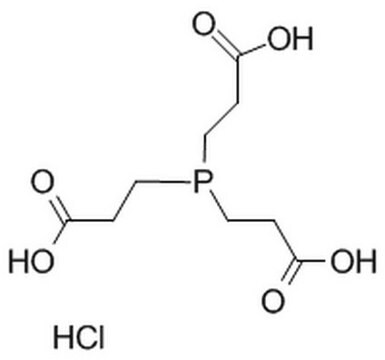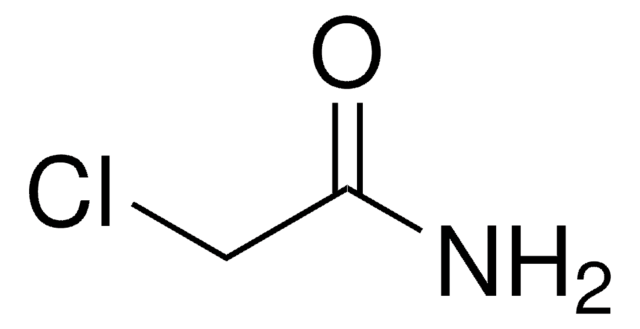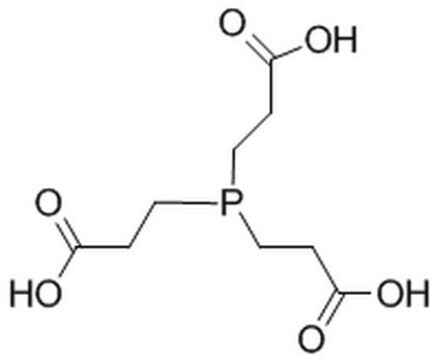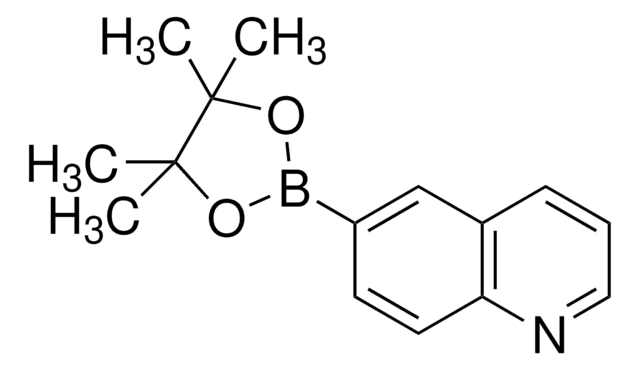646547
Tris(2-carboxyethyl)phosphine hydrochloride solution
0.5 M, pH 7.0(aqueous solution; pH was adjusted with ammonium hydroxide)
Sinonimo/i:
TCEP
About This Item
Prodotti consigliati
Livello qualitativo
Concentrazione
0.5 M
Indice di rifrazione
n20/D 1.367
pH
7.0(aqueous solution; pH was adjusted with ammonium hydroxide)
Densità
1.041 g/mL at 25 °C
Stringa SMILE
Cl.OC(=O)CCP(CCC(O)=O)CCC(O)=O
InChI
1S/C9H15O6P.ClH/c10-7(11)1-4-16(5-2-8(12)13)6-3-9(14)15;/h1-6H2,(H,10,11)(H,12,13)(H,14,15);1H
PBVAJRFEEOIAGW-UHFFFAOYSA-N
Descrizione generale
Applicazioni
- to cleave cysteine residues in a synthetic peptide
- in reduction buffer for RNA Sequential Probing of Targets (SPOTs) imaging
- for the reduction of oligonucleotides
- as reducing agent during mitochondrial isolation
Azioni biochim/fisiol
Accessorio
Prodotti correlati
Avvertenze
Danger
Indicazioni di pericolo
Classi di pericolo
Eye Dam. 1 - Skin Corr. 1B
Codice della classe di stoccaggio
8A - Combustible corrosive hazardous materials
Classe di pericolosità dell'acqua (WGK)
WGK 1
Dispositivi di protezione individuale
Faceshields, Gloves, Goggles, type ABEK (EN14387) respirator filter
Certificati d'analisi (COA)
Cerca il Certificati d'analisi (COA) digitando il numero di lotto/batch corrispondente. I numeri di lotto o di batch sono stampati sull'etichetta dei prodotti dopo la parola ‘Lotto’ o ‘Batch’.
Possiedi già questo prodotto?
I documenti relativi ai prodotti acquistati recentemente sono disponibili nell’Archivio dei documenti.
I clienti hanno visto anche
Articoli
In this study, we developed a rapid trypsin digest kit that, at elevated temperatures, yielded reliable, reproducible results in less than 2 hours on a wide variety of substrates for mass spectrometry.
Il team dei nostri ricercatori vanta grande esperienza in tutte le aree della ricerca quali Life Science, scienza dei materiali, sintesi chimica, cromatografia, discipline analitiche, ecc..
Contatta l'Assistenza Tecnica.











![Tris[(1-benzyl-1H-1, 2, 3-triazol-4-yl)methyl]amine 97%](/deepweb/assets/sigmaaldrich/product/structures/179/695/86a721c8-2a4c-4e4f-bc36-6276ce7a941f/640/86a721c8-2a4c-4e4f-bc36-6276ce7a941f.png)
